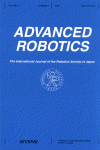
Learning, Generation and Recognition of Motions by Reference-Point-Dependent Probabilistic Models
This paper presents a novel method for learning object manipulation such as rotating an object or placing one object on another. In this method, motions are learned using reference-point-dependent probabilistic models, which can be used for the generation and recognition of motions.
The method estimates (i) the reference point, (ii) the intrinsic coordinate system type, which is the type of coordinate system intrinsic to a motion, and (iii) the probabilistic model parameters of the motion that is considered in the intrinsic coordinate system. Motion trajectories are modeled
by a hidden Markov model (HMM), and an HMM-based method using static and dynamic features is used for trajectory generation. The method was evaluated in physical experiments in terms of motion generation and recognition. In the experiments, users demonstrated the manipulation of puppets and
toys so that the motions could be learned. A recognition accuracy of 90% was obtained for a test set of motions performed by three subjects. Furthermore, the results showed that appropriate motions were generated even if the object placement was changed.
Keywords: HIDDEN MARKOV MODEL; IMITATION LEARNING; OBJECT MANIPULATION; ROBOT LANGUAGE ACQUISITION
Document Type: Research Article
Affiliations: 1: National Institute of Information and Communications Technology, 3-5 Hikaridai, Seika, Soraku, Kyoto 619-0289, Japan;, Email: [email protected] 2: National Institute of Information and Communications Technology, 3-5 Hikaridai, Seika, Soraku, Kyoto 619-0289, Japan
Publication date: 01 January 2011
- Access Key
- Free content
- Partial Free content
- New content
- Open access content
- Partial Open access content
- Subscribed content
- Partial Subscribed content
- Free trial content